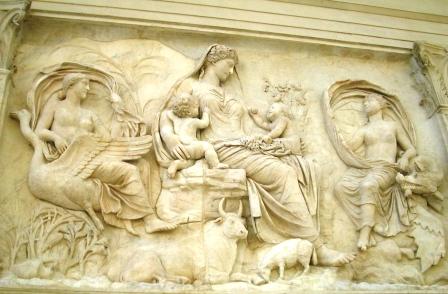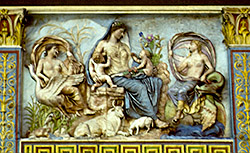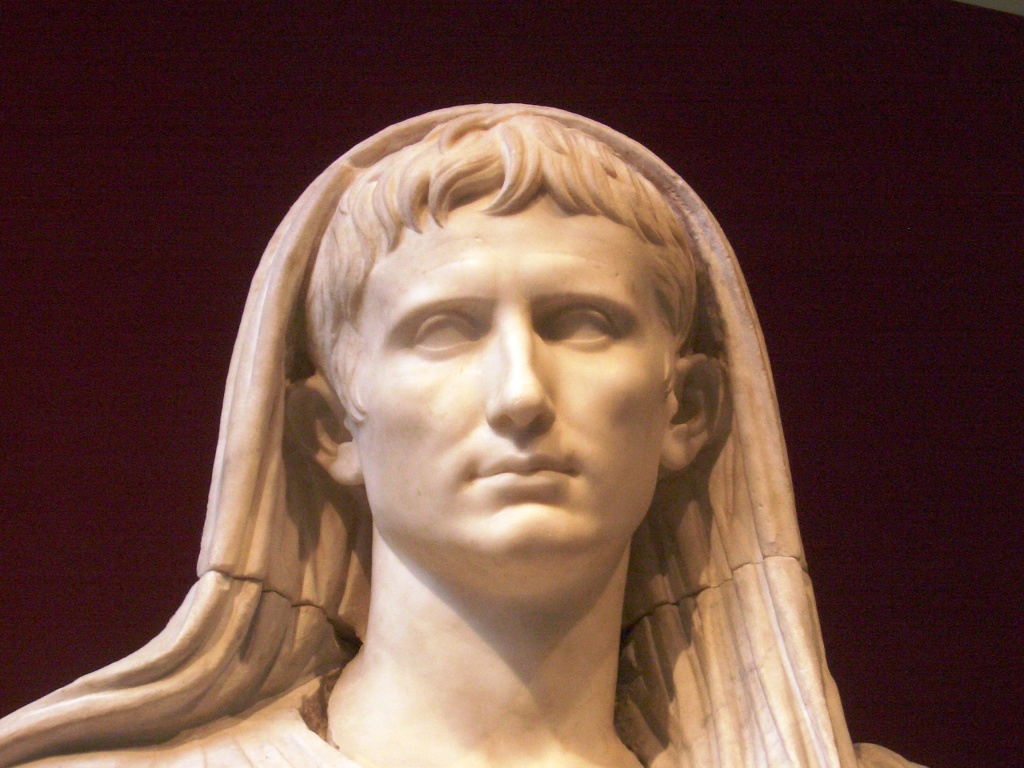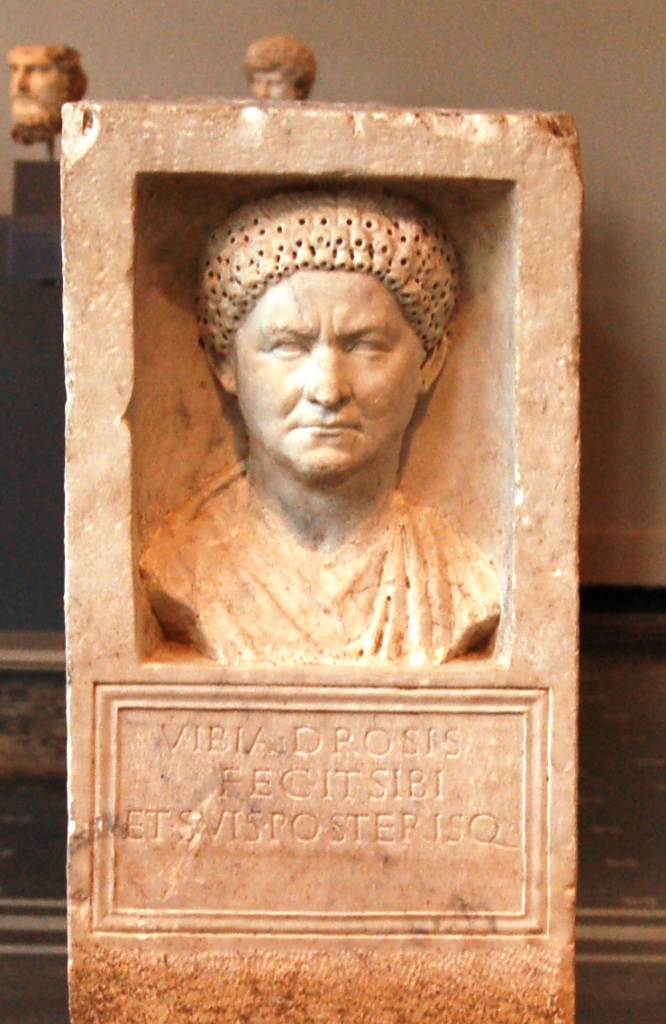|
|
|
|
| |

The Tellus panel of
the Ara Pacis, or Peace Altar.
9 BC.
Marble. Museo di Ara Pacis, Rome. A marvelous piece of propaganda
art commissioned by Emperor Augustus.
The altar was originally brightly painted:

Highlights
*
Many Roman wives were perpetually pregnant. Childhood
mortality rates were at least 40%.
*
Childbirth was extremely risky for both mother and child.
*
A family lacking a male heir simply adopted one, even an adult male. Adoption
in ancient Rome was not for the benefit of orphaned children.
*
Roman mothers were in charge of educating their children and instilling
Roman virtues. |
|
Mothers and Children in Ancient Rome
Why get married? The purpose of marriage was to create mothers who could produce children.
Lots of
them: the rate of infant mortality was staggeringly high in the ancient
world -- at least 40%.
A woman, rich or poor, might need to give birth to twelve babies to
ensure three survived past the age of 10.
Young Roman women must have been perpetually pregnant, a high-risk
venture. Many, like
Caesar's daughter Julia, died early deaths in
childbirth.
|
|
|
|
|
|
|
|
|
Childbirth
Women gave birth at home, attended by perhaps a physician,
certainly a midwife, female
relatives, and slaves of the household.
Anesthesia of course was
unknown before the 19th c AD.
Birthing techniques were a blend of science and folk medicine.
The male Greek physician
Soranus, who lived in Rome, was the leading authority on
childbirth.
Women delivered their babies using a birthing chair,
which had a back, arms, and a crescent-shaped hole in the seat, as
pictured on the right. The chair placed the mother in an upright position for
delivery. It was not used for labor.
In earliest Rome, the father had the legal right to keep the newborn or to let it die by exposure. By the time of Julius
Caesar, this custom seems to have died out. |
|

Childbirth in ancient Rome: the
birthing chair and midwife. From Tomb of Scribonia Attice,
Ostia, Italy. Terracotta. 2nd c CE.
Photo courtesy ostia.org
Soranus' treatise
"Gynecology" set out the requirements for the ideal delivery and
recovery rooms, beds, the ideal midwife, and so on. It is also one of
the few surviving works from the ancient world.
|
|
|
|
|
|
|
|
|
|
|
|
|
Adoption
The fly in the ointment: there simply were not enough aristocratic children.
Low fertility of Roman elite males; men away for long periods on
military service; the young wanting a less-encumbered lifestyle? We
don't know why. Caesar, despite his three marriages and numerous
affairs, produced only one legitimate, Roman-citizen child, his
daughter Julia.
Legally, it was difficult for the state
to elevate more families into the aristocracy.
Faced with a low birth rate, the Romans embraced adoption.
Not the kind we have today, to protect children--Roman adoption was aimed at
adults, to promote the interests of the family.
A Roman could "adopt" a male heir who was an adult, even a man who already had
his own family. And even after you the "parent" were dead; just
put it in your will. Caesar
did that. He notified the world
through his will that he
had adopted his nephew Octavian.
Through this legal instrument, he
bequeathed to Octavian
his political mantle as well as financial resources.
Octavian later became the Emperor Augustus.
He tried to increase the number of children by fiat.
|
|

Emperor Augustus/ Octavian. Roman.
Marble bust, National Museum of Rome, Palazzo
Massimo.
Marriage edicts of Augustus:
--Aristocratic wives who had fewer than three children were penalized.
--Women with no children could receive only half of their normal
inheritance. Bachelors had similar penalties.
--Widows and divorced wives under the age of 50 had to remarry quickly
or lose certain legal and social rights.
--Romans of the aristocratic classes greeted Augustus'
fertility rules with a big
"ho-hum", and little obedience.
|
| |
|
|
|
|
|
|
| |
|
|
Educating the children
Roman mothers ruled the household roost.
Once the infant survived the first few years, a Roman mother was responsible for his or
her education. The mother selected the tutor, who provided
home-schooling.
Roman elite male children, and many female children, learned Greek,
Latin, public speaking and a wide variety of other subjects.
She had even more duties: Rome lacked organized social institutions like
churches, public schools, and the like. The good Roman mother was also responsible for instilling the Roman
virtues in her children.
What were these virtues? To be a Roman meant something special and specific: self-control, dignity, respect for the Roman gods, and above all,
loyalty to the family and its ancestors.
The Romans believed these
virtues were needed to maintain the Roman state and society.
Sometimes mature, virtuous heads might be
attached to nubile, sexy-young-goddess bodies. The Romans saw no
contradiction: both fertility and modest
self-restraint were their highest female ideals.
|
|

Funerary stele of the matriarch Vibia
Drosos. Roman. Marble, 2nd c CE. Roman. New York Met.
This Roman mother almost radiates with
Rome's idealized virtues. No dreamy, pale oval face for her. Notice her square face. Her solemn gaze. Her wide
chin. All symbols of the ideal Roman mother: dignified, self-restrained,
modest.
|
|
|
|
|
|
Updated 07-February-2018. You may contact me, Nancy
Padgett, at
NJPadgett@gmail.com |
|
|
|
|
|
|